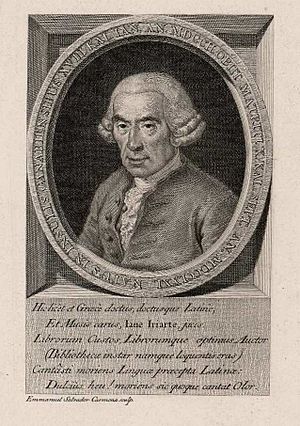Juan de Iriarte facts for kids
Quick facts for kids
Juan de Iriarte
|
|
|---|---|
 |
|
| Born | 15 December 1701 Puerto de la Orotava, Spain
|
| Died | 23 August 1771 (aged 69) Madrid, Spain
|
| Seat Z of the Real Academia Española | |
| In office 21 September 1747 – 23 August 1771 |
|
| Preceded by | Miguel Gutiérrez de Valdivia |
| Succeeded by | Pedro de Silva y Sarmiento de Alagón |
Juan de Iriarte (born December 15, 1701 – died August 23, 1771) was an important Spanish writer. He was also a translator of French and English for the Royal Chancery. He was known for his knowledge of ancient Greek (a "Hellenist") and Latin (a "Latinist").
Contents
Juan de Iriarte's Early Life and Education
Juan de Iriarte was born in a town called Puerto de la Orotava. This place is now known as Puerto de la Cruz in the Canary Islands, Spain.
When he was about 12 years old, in 1713, he went to Paris, France, for his education. An interesting fact is that the famous writer Voltaire was one of his students there. Later, Juan de Iriarte moved to London, England, to continue his studies.
Moving to Madrid and Royal Library Work
After finishing his education, he moved to Madrid, the capital of Spain. There, he got an important job at the Biblioteca Real, which is the Royal Library.
When he was 28 years old, in 1729, he created his first catalog. This catalog was called Regia Matritensis Bibliotheca. It listed all the books and documents kept in the Royal Library.
Teaching and Academic Achievements
The head librarian, Juan de Ferras, helped him get a special job. Juan de Iriarte became a private tutor for important families. He taught the children of the Duque de Béjar and the Duque de Alba. He also taught Royal Prince Manuel de Portugal.
Juan de Iriarte was the uncle of another famous writer, Tomás de Iriarte y Nieves Ravelo. Tomás was known for his poems and plays.
Juan de Iriarte wrote a book called Gramática latina (which means Latin Grammar). He also wrote for a newspaper called Diario de los Literatos in 1737. In 1741, he was chosen to be a member of the Real Academia Española. This is a very important group that looks after the Spanish language. He also joined the Academia de Bellas Artes de San Fernando, an academy for fine arts.
Juan de Iriarte's Published Works
Juan de Iriarte wrote many different kinds of books and papers. He wrote about how dictionaries could be better in Sobre la imperfección de los diccionarios. He also studied ancient Greek writing in Paleografía griega (Greek Paleography).
He wrote Bibliotheca graeca (Greek Library), which described old Greek handwritten books. He even wrote about Spanish bullfighting in a work called Tauromaquia matritensis, sive taurorum ludi.
Here are some of his other important works:
- Obras sueltas de don Juan de Iriarte, Madrid, 1774 (two volumes)
- Regia Matritensis Bibliotheca (1729)
- Sobre la imperfección de los diccionarios, a speech he gave when he joined the Real Academia Española de la Lengua in 1747.
- Colección de refranes castellanos traducidos en metros latinos, 1749 (a collection of Spanish sayings translated into Latin poems).
- Sobre los verbos reflexivos y recíprocos, 1756 (about certain types of verbs).
- Advertencias sobre la sintaxis castellana, 1755 (advice on Spanish grammar).
- Gramática latina, 1764 (his Latin grammar book).
- Paleografía griega, 1760 (his book on Greek handwriting).
- Bibliotheca graeca (his Greek library book).
- Tauromaquia matritensis, sive taurorum ludi (about bullfighting).
- Lista de los Principales Manuscritos de la Librería de los Marqueses de Villena. This list of important old books was made in 1725.
See also
 In Spanish: Juan de Iriarte para niños
In Spanish: Juan de Iriarte para niños

